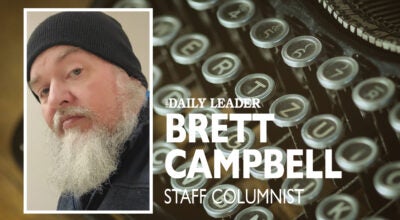Resurgam: Grave words say a lot
Published 9:59 pm Tuesday, September 26, 2017
“. . . a grey marble tablet marks the spot, inscribed with her name, and the word, ‘Resurgam.’”
That’s a line from Jane Eyre regarding the grave of a character in that book named Helen. I spotted the Latin word on a couple of tombstones in Vicksburg’s Cedar Hill Cemetery last Saturday too. It means “I shall rise again.”
Nice, I thought to myself when I saw it on the aged marble. Way to pack a punch in just eight letters. People in the 19th century were just so . . . so . . .
What?
Succinct? Clever? Sure of themselves?
As Daughter No. 2 wandered away with her camera and a developing interest in history, I took a slower path. I wanted to concentrate on the crumbling monuments, the ones inside gated family plots — the ones with the interesting epitaphs. I stopped at any with extra lines inscribed below the hyphenated life span. Knocking away moss, I bent low and squinted my eyes like a cryptologist examining the Rosetta Stone.
The more I read, the more I noticed a pattern emerging. Most folks back then had something to say on their tombstones, and they said it plain: “Thy will be done,” “All is well,” “To die is gain,” “Absent, not dead,” “I know that my Redeemer lives,” and “Bless the Lord, O my soul.”
That thought was confirmed again at Port Gibson’s Wintergreen Cemetery at the spot occupied by Aseneth Maria Spencer’s earthly remains. She “died in the full assurance of Hope.”
Anne Jane Butler, 23, evidently did as well: “She early professed her faith in Christ. Her end was perfect peace.”
Not the words of a fluffy faith, for sure.
Maybe young people just had a more serious bent back then. Seeing all your siblings die during a yellow fever epidemic could tend to do that, I suppose. Even so, I’d like to ask Miss Mary E. Ross how she came to have the maturity to die “in Christ and confidence” at age 19. Too bad I missed her by more than 160 years.
Long-lifers had some moving tributes as well. One son paid homage to his father by doing a remake of Proverbs 17:6: “The memory of a good man is the heritage of his people and the pride and comfort of his children.”
Another family chose these words from Psalms to honor their patriarch: “Mark the perfect man, and behold the upright: for the end of that man is peace.”
But here’s my favorite, one I sent to my daughters and daughters-in law. Lucy M. Cotton, wife of itinerate preacher Reverend J. A. Jones, died August 24, 1894 — “a self-sacrificing, earnest, consistent Christian from childhood; fulfilling every obligation, performing every duty; strong in faith, abundant in good works.”
Ah, what a summation. Those are the kind of words that live on, even as the brick edifices surrounding them fall into disarray.
For curiosity’s sake, I took a stroll through some of the graves bearing death dates from more recent years. Not many had the extra layer of information that an epitaph offers. One, however, did have a vase bearing the Greek letters of her sorority. Another showed a penchant for the outdoors with an engraved mural on the back of his headstone.
And while everything we need to know about life certainly can’t be learned at a cemetery, it might be good to visit one every now and then. Among the rows, you can’t help but do the math and get a sense of your place in the big scheme of things. Who knows? You just might run across a word like resurgam.
Latin like that can stop you in your tracks — and give a community dealing with all that death (like I wrote about last week) something to think about.
Kim Henderson is a freelance writer. Contact her at kimhenderson319@gmail.com.





